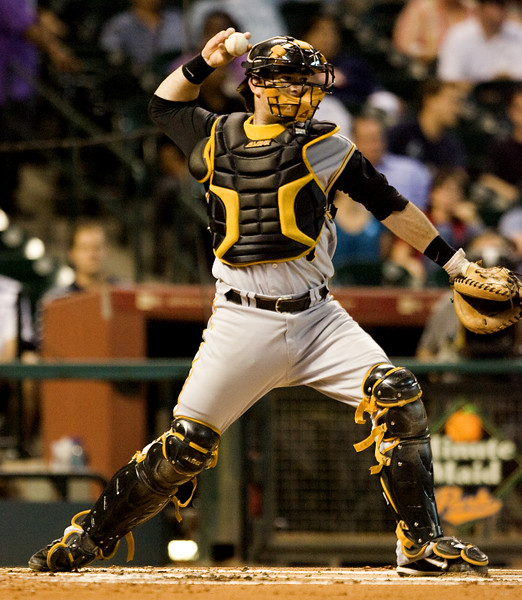- Every player not on the 40-man roster, is eligible for all 3 parts of the draft, if a. he was 18 or younger when signed and signed before 2007 or b. 19 or older and signed before 2008.
- For the MLB part, every player not on the 40-man roster qualifies for the draft.
It gets a bit tricky in the AAA and AA parts (and here is a link from MiLB.com that explains some things) but the story is something like this: For every minor league level, there is what is called the reserve roster (38 in AAA, 37 in AA, and 35 on each A and Rookie ball teams). Players who satisfy the age and contract length requirements who are not on the AAA reserve roster are subject to the AAA part of the draft. Players who satisfy the age and contract requirements who are on the AA (and AAA) reserve roster are subject to the AA part of the draft. This is regardless whether they are in a lower reserve roster. ie. if a player is on a team's AA reserve roster (and not on a AAA roster) and satisfies the age requirements, he is subject to the AAA part of the rule 5 draft. - Players selected on the MLB part of the draft have to be on the 25 man (active roster) for the whole season. Players selected in the AAA part of the draft have to be in the AAA reserve roster for the whole season and players selected in the AAA part of the draft have to be in the AAA reserve roster for the whole season. Unlike in the majors, a player can be in a higher level reserve roster and play in a lower level in the minors. So a Twins' player in the Fort Myers' reserve roster can be selected by another team, added to their AA reserve roster and still play A ball
Here is a list of the Twins' players eligible for the Rule 5 draft. Players in bold are players who can potentially be selected in the MLB portion and players in italics are players who can potentially be selected in the AAA and AA parts, if they are not protected in the corresponding reserve roster. All the minor league free agent signings are also subject to the Rule 5 draft, but I did not include most of them here (age in 2011 season, position, leagues and performance are included) :
Andrew Albers (25, LHS/R) A+/AA 2.16 ERA, 95.2 IP, 1.108 WHIP, 7.5 K/9, 5.71 K/BB
James Beresford (22, LH IF) A+ .270/.328/.299, 545 PA
Evan Bigley (24, RH OF) AA .253/.311/.378, 536 PA
David Bromberg (23, RHS) Rk/AA 6.43 ERA, 42 IP, 1.738 WHIP, 6 K/9, 1.56 K/BB (coming back from injury, up to AAA in 2010)
Chris Cates (26, RH IF) AA .205/.258/.245, 220 PA
Ray Chang (27, RH IF) Rk/AA/AAA .271/.323/.368 266 PA
Cole DeVries (26, RHS/R) AA/AAA 3.40 ERA, 90 IP, 1.267 WHIP, 7.5 K/9, 3.26 K/BB
Brian Dinkelman (27, RH UT) AAA/MLB MLB: .301/.346/.315, 78 PA; AAA: .243/.316/.324, 526 PA
Mark Dolenc (26, RH OF) AA 266/.323/.347, 418 PA
Phil Dumatrait (29, RHR) MLB/AAA 3.92 ERA, 41.1 IP, 1.694 WHIP, 6.3 K/9, 1.16 K/BB
Nelvin Fuentes (22, LHR) A 3.29 ERA, 38.1 IP, 1.070 WHIP, 10.1 K/9, 3.91 K/BB
Jhon Garcia (24, RHS/R) A+ 3.82 ERA, 77.2 IP, 1.442 WHIP, 7.2 K/9, 2.07 K/BB
Jonathan Goncalves (22 RH OF) A/A_ .231/.340/.298, 346 PA
Pedro Guerra (21 RHS) Rk/A 4.21 ERA, 1.327 WHIP, 10.9 K/9, 4.44 K/BB
Anderson Hidalgo (22, RH, IF) A+ .274/.332/.395, 384 PA
Steve Hirschfeld (25, RHS/R) AA 3.73 ERA, 1.250 WHIP, 6.3 K/9, 2.09 K/BB
Michael Hollimon (29, RH UT) AA/AAA .231/.326/.416 521 PA
Shooter Hunt (24, RHR/S) A+ 7.38 ERA, 2.367 WHIP, 9.7 K/9, 0.75 K/BB
Edgar Ibarra (22, RHS/R) A+ 5.16 ERA, 1.712 WHIP, 6.5 K/9, 1.57 K/BB
Brett Jacobson (24, RHR/S) AA 4.56 ERA, 1.430 WHIP, 7.2 K/9, 1.38 K/BB
Bobby Lanigan (24, RHS) AA 4.45 ERA, 1.458 WHIP, 5.9 K/9, 2.53 K/BB
Danny Lehmann (25, RH C) AA/AAA .234/.315/.323, 219 PA
Wang-Wei Lin (23, RH OF) A .276/.372/.358, 413 PA
Angel Morales (21 RH OF) A+/Rk .259/.314/.400 135 PA (injuries)
Miguel Munoz (22 RHS/R) A+/Rk 7.50 ERA, 1.833 WHIP, 1.5 K/9, 0.22 K/BB (injuries)
Jairo Perez (23 RH IF) A .337/.413/.580, 276 PA
Josmil Pinto (22, RH C) A/A+ .261/.301/.395, 253 PA
Bruce Pugh (22 RHR/S) A+/AA 5.91 ERA, 1.593 WHIP, 10.5 K/9, 2.34 K/BB
Danny Rams (22 RH C) A+ .239/.310/.388, 309 PA
Jairo Rodriguez (22 RH C) Rk .217/.265/.264, 106 PA
Deibinson Romero (24 RH 3B) AA .256/.327/.411, 414 PA
Anthony Slama (27 RHR) AAA 2.92 ERA, 1.162 WHIP, 10.2 K/9, 2.62 K/BB
Yangervis Solarte (23, RH IF) AA .329/.367/.466, 459 PA
Manuel Soliman (21, RHS) A 3.97 ERA, 1.309 WHIP, 7.9 K/9, 2.40 K/B
Spencer Steedley (26, RHR/S) AA 4.52 ERA, 1.649 WHIP, 7.1 K/9, 1.67 K/BB
Tom Stuifbergen (22, RHS) A/AAA 4.29 ERA, 1.430 WHIP, 5.9 K/9, 4.21 K/BB
Michael Tarsi (24, RHR) AA/AAA 3.86 ERA, 1.686 WHIP, 6.7 K/9, 1.18 K/BB
Reggie Williams (22 RH UT) A/A+ .256/.317/.359, 273 PA
Realistically I think that Cole DeVries, Andrew Albers and Anthony Slama can all be drafted by an MLB team; as a matter of fact, after DeVries' AFL performance, I will be very surprised if he is not drafted. I do not think that any of the others are MLB-ready, but if not protected in the AAA reserve roster, the ones indicated would have a high probability in changing teams. I do think that Hirschfeld will be on the AAA roster. Angel Morales, Pedro Guerra, Nelvin Fuentes, Jairo Perez, Danny Rams and Yangervis Solarte are all good players and a couple of years away from the majors, so there is a high likelihood of departure if not on the AAA roster.
What do you think?






